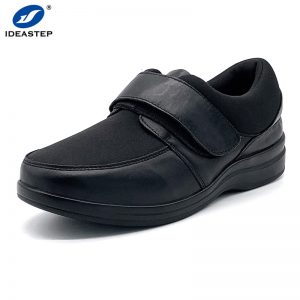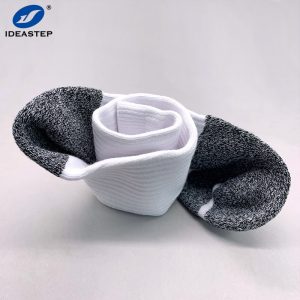Wearing shoes and socks is a very common thing, especially young friends choose high heels, pointed shoes, etc. to show their personality, such as Lady Gaga’s various styles of shoes attract the attention of fashion and trends. But for diabetic friends, there are more choices when facing shoes and socks, because if you wear them carelessly, it may induce foot lesions. The shoes mentioned above are likely to have foot deformities and ulcers. Disaster.
Diabetes can easily lead to foot pathology and lead to deformation of the patient’s foot. Diabetic patients need to choose a suitable pair of shoes.
How do diabetics choose shoes?
Diabetic foot is one of the serious complications of diabetes, with a very high rate of disability and fatality, so it is very important to do a good job in prevention. Choosing the right shoes for walking every day is one of the most important aspects of prevention, but many patients do not know how to choose shoes. Diabetics should pay attention to the following points when choosing shoes:
1. Soft and comfortable
The shoes worn by diabetic patients must be soft and comfortable, not too hard, soft shoes can reduce the pressure caused by the shoes on the feet. The soles should also be soft and elastic, which can cushion the pressure on the soles of the feet.

2. Choose lace shoes
Diabetes patients are best to choose shoes with laces, because the feet of patients are often prone to swelling, and laced shoes can adjust the tightness of the shoes at any time. At the same time, it can also prevent the shoes from falling off due to numbness and insensitivity of the feet. When buying shoes, be sure to try them on yourself and pay attention to leaving enough space for toes, arches, heels, and other parts.
3. Custom-made shoes
Among the many complications of diabetes, the diabetic foot has a very high disability and fatality rate, so prevention is very important.
Sugar friends often neglect the maintenance and care of the feet when dieting and medication control blood sugar, so that ulcers and gangrene will occur.
Diabetic foot is a common chronic complication of diabetes. In severe cases, amputation is required. 40% of patients with diabetes for more than 10 years are at risk of diabetic foot disease. Not only does it have high medical costs, but it may also cause disability and death. At present, in addition to hospitalization, for patients who want to reduce the chance of recurrence of ulcers after discharge from the hospital, special insoles should be customized if conditions permit.
Many patients do not understand why wearing special insoles can reduce the incidence of diabetic feet?
Special insoles for diabetic feet are specially customized for different patients. The method is to first use a plantar pressure detector to detect the pressure on the patient’s soles when standing and walking and make personalized insoles based on the test results. The customized insole can balance the plantar pressure, reduce the damage to the plantar caused by heavy pressure, ensure smooth peripheral microcirculation, and avoid the occurrence of diabetic foot.
Because the insole is specially customized, it fits closely with the patient’s arch, which can make the patient’s walking easier. Moreover, the material of the insole is moderately hard and soft, which can also reduce the incidence of calluses and corns in patients.

Ideastep diabetic insole environmental removeable pegs foot pain surgery insoles for unheal foot ulcer
The basic features of podiatry prevention and protection shoes:
· Designed by a podiatrist. In foreign countries, it needs to be certified by relevant medical insurance institutions, and patients can get it for free
· Lightweight and fit. With laces and Velcro.
· Specific depth. The insoles can be replaced and are deep enough to accommodate customized personalized insoles.
· Spacious toe space. The toe is round, with enough width and depth at the toe to avoid squeezing.
· Good air permeability: The fabric is made of elastic synthetic fiber fabric (lycra) or high-quality soft leather, and Lycra has a certain degree of ductility.
· The inside of the shoe is flat and smooth: there are few shoebox linings without seams to prevent friction damage.
· Shock-absorbing soles: flat-heeled rubber soles are often used, and the back of the shoe has a certain natural curvature.
· Biomechanical insoles: Diabetic shoes are usually equipped with special insoles to support the physiological arch, disperse plantar pressure, and improve comfort and fatigue resistance.
Precautions when buying and wearing shoes
· You should buy shoes in the afternoon because your feet will be swollen in the afternoon. It is suitable to try on in the morning, but it may not be suitable in the afternoon.
· When buying shoes, wear socks to try on shoes.
· Try on both feet at the same time.
· Be slow when wearing shoes.
· For new shoes, after wearing them for 20-30 minutes, take them off to check whether there are reddened areas or signs of friction on your feet.
· For new shoes, start wearing 1-2 hours a day and gradually increase the wearing time to ensure that potential problems are discovered in time.
· Before putting on shoes, check whether there are rough seams or foreign objects in the shoes. Don’t wear sandals with exposed toes, and don’t wear shoes barefoot.
Socks are also very important.
The choice of socks:

Material: Choose wool socks or thread socks with good water absorption and air permeability; socks that are not tight or tight will hinder the blood circulation of the foot and cause local edema; if the socks are too loose, it is easy to form wrinkles on the soles of the feet, causing local Increased pressure.
Color: It is best to be light-colored, change, and wash daily to facilitate observation of ulcers and oozing on the feet.
A journey of a thousand miles begins with a single step, adding some common sense, changing some living habits, protecting the feet, and having a pair of healthy feet, is the only way to enjoy the beautiful scenery.
Hot blogs:
The Easiest Custom Insoles: Heat Moldable Insoles
Custom insoles, also known as orthotic insoles, are designed to provide personalized support and comfort for individuals with various foot conditions. In [...]
Children’s Insole Size Conversion Chart
The standard sizes for shoe insoles may vary from country to country, making it a headache to choose the right insole for [...]
Do custom orthotics need to be made by a doctor personally?
Custom orthotics do not necessarily need to be made by a doctor personally. While doctors, specifically podiatrists or orthopedic specialists, are often [...]
Do NBA players use custom insoles?
Custom insoles are not only helpful for people with foot health issues, but they also play a significant role in targeting the [...]
